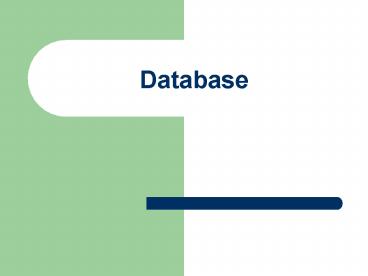Database - PowerPoint PPT Presentation
1 / 19
Title:
Database
Description:
Telephone directories. Advantages of an electronic database ... 33 East Street. Tom. Adams. Zip. State. City. Address. First Name. Last Name ... – PowerPoint PPT presentation
Number of Views:36
Avg rating:3.0/5.0
Title: Database
1
Database
2
What is a Database
- A database is an organized collection of
- related information.
- An electronic database is an efficient means
- of storing and retrieving data and
- printing reports from the stored data.
3
Database Terms
- A file is a collection of related records
- An entry is data that is in a field
- A field is one category of information
- A field name is the title that is assigned to a
field - A record is a group of related fields of one item
of information in the database. It make up one
row of data - The Primary Key or Key field is the unique
identifier for the database - The Primary Sort is the first field used to sort
a database (like a last name) - The Secondary Sort is the second field used to
sort a database
4
- indicates that the data in a field is too long
- Sort is arranging records in either ascending or
descending order - Search, querying, or filtering is to find certain
criteria based on given data - Connectors are the words and, or, and not used in
a search, query, or filter - Comparison operators are (lt, gt, lt, gt, , ltgt)
- Example To find all the people with last names
of Smith in Morehead City, your query/filter
would be - Last name Smith
- City Morehead City
5
- Design View is the view of the database that
allows the setting up of the fields and entering
the data - List View shows the records in a database and the
fields similar to a table - Report View shows the records displayed after
search or filtering a database
6
Commonly used databases
- A file is the collection of related records.
- Address books
- Dictionaries
- Encyclopedias
- Library card catalogs
- Patient data
- Student data
- Telephone directories
7
Advantages of an electronic database
- Used to organize large amounts of data
- Accurate, quick and efficient arrangement of data
in alphabetical or numerical order - Ability to find and retrieve data
- Ability to generate reports on the database
- Ease of editing existing data
8
Disadvantages of an electronic database
- Takes good planning before beginning the database
- Difficult to read text
9
Steps to design a database
- Plan and design the database according to needs
and requirements - Determine the fields or categories that will be
used in the database - Determine field properties to include size and
type
10
Techniques/Devices to input data
- Keyboard
- Mouse
- PDAs
- Scanners
- Speech Recognition Software
- Web forms
11
Example of an entry
Entry
12
Examples of fields
Fields
13
Examples of records
Records
14
Example of database file
15
Typical views of a database
- List view
- Displays several records on the screen at a time
- Form view
- Displays one record on the screen at a time.
- Commonly used in data entry.
16
General data types
- Currency ()
- Date (03/03/03)
- Numeric (450)
- These numbers can be used in calculations
- I.E. Gross pay, basketball statistics, etc.
- Text/General (Smith)
- Numbers may used, but would not be computed
- I.E. Social security numbers, telephone numbers,
etc.
17
Sortingto arrange data in alphabetical or
numerical order
- Ascending order (1-10 or A-Z)
- 1,2,3,4,5
- Adams, Petteway, Rodriquez
- Descending order (10-1 or Z-A)
- 5,4,3,2,1
- Rodriquez, Petteway, Adams
18
Primary/Secondary Sorts
- Primary key The field selected as the unique
identifier for the database.(i.e. Student
number) - Primary sort The first field that a database is
sorted on. - Secondary sort The second field that a database
is sorted on.
Primary Key Student No.
Secondary Sort Age (in ascending order)
Primary Sort Last name (in Descending order)
19
Searching/Querying/Filteringto find specific
data based upon a given criteria or condition
- Queries/Filters use connectors and comparison
operators to define the search criteria - Connectors (AND, OR, NOT)
- Comparison operators (lt, gt, lt, gt, , ltgt)































